| Trygve.Com > Diary > "We're Surrounded!" | Translate this page:
|
Oh, wait ... this picture was taken near the end of the Dragon and the Hawk Surround Mix Saga; ...but, then, what's a little foreshadowing between friends?
|
|
Except for the "job interviews" for actors and stunt performers; those are probably more interesting and varied than the "I'm seeking a challenging and rewarding career in the field of toaster oven design." variety.
|
But once you shift into full production mode, filmmaking becomes a lot less like manufacturing small electric home appliances. For starters, movie audiences tend to be pickier about how your film sounds than most kitchen appliance users are about the quality of the sound emanating from a blender. On the Dragon and the Hawk shoot, our "tactical sound unit" was headed by Dave Schaaf [ http://www.mhss.com/ ], who was aided and abetted by Bryan Strickland, Mark D. Kilburn, and Devendra Damon Cleary (who's now off in California doing the soundwork on Buffy the Vampire Slayer). |
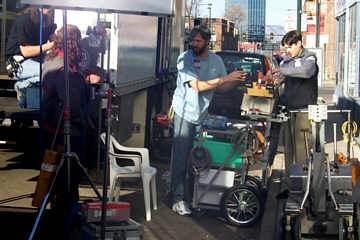 Dave Schaaf and Devendra Damon Cleary |
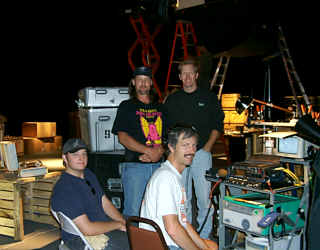
(clockwise from front center) Dave Schaaf, Bryan Strickland, Mark D. Kilburn, and George Ball |
Having been through the audio editing and mastering process twice now makes me really appreciate Dave's attention to detail on our shoots. For every single location and set we shot in, we have a collection of "room tone" recordings of how the room itself sounded, often with multiple variations of equipment (including kitchen appliances when they appeared in a scene) turned on and off. Every room has a different "sound" to it whether something's happening or not. As long as it's the right sound, you normally just filter it out, but if it's the wrong sound or it abruptly disappears or changes, then you notice. If you're not sure what I'm talking about, stand in a hotel's back staircase with your eyes closed and then in one of the ballrooms (you can open your eyes while you're going from one to the other if you want). |
|
Most sound recording these days is done digitally--and ours was no exception--which means that if the recording level is too high, you get horrible clipping and distortion of the waveform, but if it's too low, the noise level starts creeping up on you. Given the choice, more noise is almost always less awful than catastrophic clipping, but once the take is done, it's too late to change your mind about how the levels should have been set. Action movies and TV shows are particularly challenging because the dynamic range between vocals and effects (explosions, crashes, gunfire, etc.) is so great. Fortunately, one of the things that Dave Schaaf did during filming that proved invaluable during the post-production soundwork was to take multiple feeds at different levels, so that if one track was clipped, we could use the next track down. |
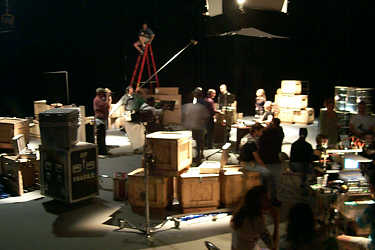 |
Dave Schaaf and several other sound crewpeople wrote an "Open Letter to Directors from Your Sound Department"
that appeared in Mix Magazine a while back; there's a copy available online at:
[ http://www.proaudio.net/

George Flynn, who provided the voice of the "Macao Agent" in Dragon and the Hawk as well as the voiceovers on the theatrical trailer and radio commercials, was the audio post-production supervisor on the film. Here he and director Mark Grove (right) and Randy Hansen (left) go over some of the finer details of making the soundtrack synchronize properly with the on-screen action. |
With the shooting done and the editing of the visual part of the film well underway, it was off to Fanfare Productions to assemble the location sound into a cohesive whole, replace lines of dialog where necessary, add effects and foley, and match it all back to the film once its editing was completed. |
(Just in case you're unfamiliar with what "foley" means, it's where you go back through the film and rustle paper, shut doors, fiddle with your car keys, and that kind of stuff in time with the people on the film so you can adjust and place those sounds as discrete entities instead of having them locked to the location dialog recording. The name comes from a sound engineer named Jack Foley who used to work at Universal Studios back in the 30's.) |
|
While the dialog and sound effects were being edited and tweaked, Guy Bianchini was already working on the musical score. Working on the music was quite an experience in itself, as Guy's detailed and varied score not only added to the scenes and enhanced the action and mood that was there, but sometimes brought out nuances in the feeling of a scene that I hadn't even thought about during the filming. |
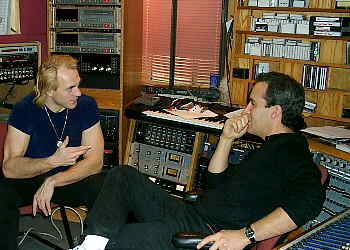
One of the recording rooms at Fanfare's Golden studios where the live instruments and vocals for the soundtrack were recorded. |
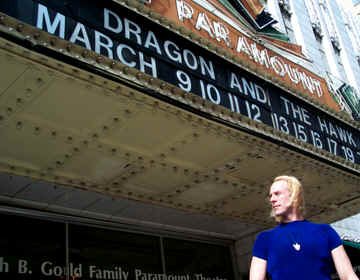 |
Dragon and the Hawk held its premiere at Denver's Historic Paramount Theatre and over its theatrical run I managed to sneak in a few times to observe the audience reactions--which gave me some pretty clear feedback on what parts of the soundtrack needed to be brought up a bit, which parts could sound better, and how the placement and/or timing could be improved. Even though the movie was always the same, each audience was a little different from all the others. I don't really know why, but in one showing it would seem like the whole audience would react strongly to particular parts while others that had just produced the strongest reactions in the previous showing would slip right by. |
|
And so, with the experience gained from the theatrical run, it was off to the Digital Media Center to start work on the soundtrack again. |
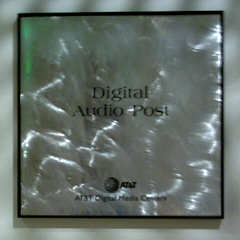
Audio Post at the Digital Media Center |
(There's nothing like actually seeing your work on the big screen to make you realize how it could be improved--and there's nothing like gearing up for the home video release to give you the opportunity to do so.) |
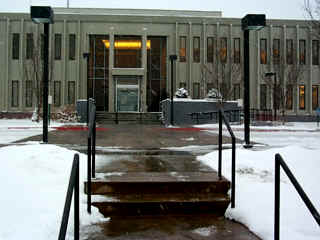
snowy day at the Digital Media Center |
The first time I'd been out to the audio post-production facilities at the Digital Media Center was on a cold and snowy day back in February, but it wasn't until mid-July that we really got started rebuilding the audio for surround. |
|
We had the incredible luck to have Bruce Marshall [ http://www.audioboy.com/links.html ] doing the re-recording and surround mixing. Bruce is better known for his engineering work with King Crimson, Adrian Belew, Robert Fripp, Sting, ZZ Top, Neil Young, and many other household words in the music biz, but he does work on TV and video as well, ranging from several shows on Animal Planet and The Discovery Channel to feature films like Dragon and the Hawk. |
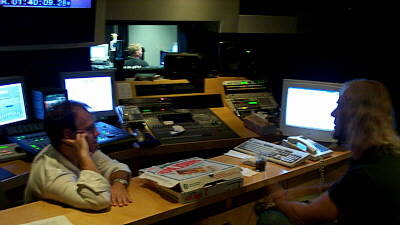
planning the remix with Bruce C. Marshall |
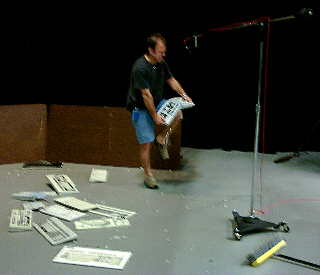 we spent days breaking keyboards, cups, and other household (and evil stronghold) obejcts, just to get the right sounds |
When you're breaking down a mix into its component elements (in this case, the sound mix done for the theatrical run) in preparation for rebuilding a new mix, there'll always be those effects or even segments of the original location audio that you realize could stand some improvement. Just because something is real doesn't mean that it sounds real. |
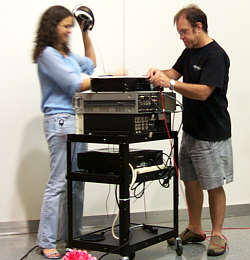 |
It's not just any engineer who will volunteer to be thrown repeatedly against a pair of heavy glass doors just to improve on the location sound. |
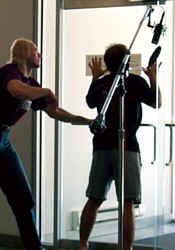 |
I got into the foley action as well, revisiting some of the fight scenes and spending more time than I'd ever done before hitting myself with a large metal gas can. It's a dirty job, but someone's got to do it.
... at least that's what they tell me.
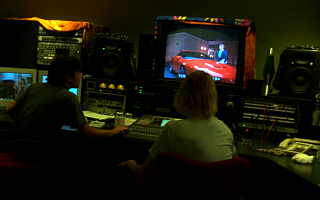 retrieving the original location audio with Jim Boardman in the DAT room |
For most of the dialog, we used the dialog mix that was done for the theatrical release; that's one thing that translates more easily between the mixes for film, Dolby pro-logic, and Dolby Digital 5.1. Some parts we still wanted to rebuild from scratch, so we did give our original location sound DAT tapes another workout. |
|
Most of the work we did on Bruce's state-of-the-art Protools system with all the latest plugins and testing equipment from Dolby Laboratories. |
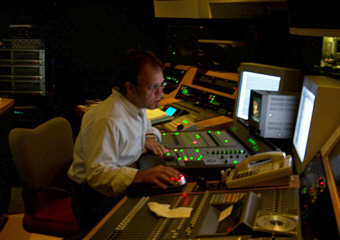 |
|
But every once in a while, we still made use of a few not-so-hi-tech approaches... |
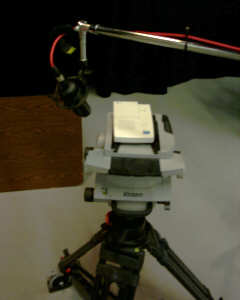 |
...such as this technique for making voices sound like they're being played back on an answering machine.... |
|
The whole re-recording, surround mixing, and encoding for the Pro-Logic and Dolby Digital surrounds took about six weeks of plugging away until somewhere around midnight every day, but eventually it was done, everything tested out on a variety of playback systems and decoders, and the newly remastered soundtrack went off to FotoKem for the DVD authoring and the analog version (with the ProLogic soundtrack) went off to the VHS replicators. |
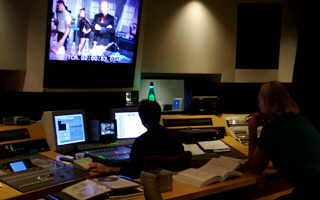
|
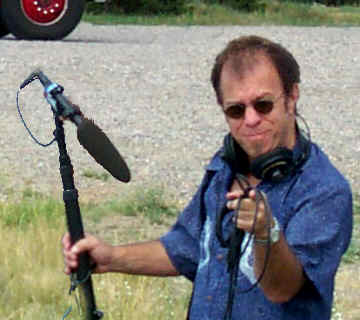 |
So, look for copies of the home video release of Dragon and the Hawk in stores near you and through online retailers this November! |
|